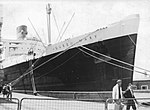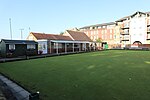Port of Southampton

The Port of Southampton is a passenger and cargo port in the central part of the south coast of England. The modern era in the history of the Port of Southampton began when the first dock was inaugurated in 1843. The port has been owned and operated by Associated British Ports since 1982, and is the busiest cruise terminal and second largest container port in the UK. The volume of port traffic categorises Southampton as a Medium-Port City globally.The port is ten miles (16 km) inland, between the confluence of the rivers Test and Itchen and the head of the mile-wide drowned valley known as Southampton Water. The mouth of the inlet is protected from the effects of foul weather by the mass of the Isle of Wight, which gives the port a sheltered location. Additional advantages include a densely populated hinterland and close proximity to London, and excellent rail and road links to the rest of Britain which bypass the congestion of London. The average tidal range is approximately 5 feet (1.5 metres), with 17 hours per day of rising water thanks to the port's "double tides". These allow the largest container and cruise ships access to the port for up to 80 per cent of the time, according to the container terminal operator DP World Southampton. The effect is a result of tidal flow through the English Channel: high tide at one end of the Channel (Dover) occurs at the same time as low tide at the other end (Land's End). Points near the centre have one high water as the tidal swell goes from left to right, another as it then goes from right to left. Neither is as high as the one at each end.The principal berths are divided into three areas, The Old Dock at the junction of the Rivers Test and Itchen consisting of berths 20–49; The New Dock, known as the Western Dock, built by the Southern Railway consisting of Berths 101–110; and the Container Terminal consisting of berths 201–207. The container terminal was constructed entirely on reclaimed land, with berth 201 opening in 1968. The berths at the container terminal have since been renamed. Berths 207 to 204 are now berths SCT 1 to 4 respectively and the reconstructed berths 201/202 now SCT 5.
Excerpt from the Wikipedia article Port of Southampton (License: CC BY-SA 3.0, Authors, Images).Port of Southampton
Old Road, Southampton St Mary's
Geographical coordinates (GPS) Address Nearby Places Show on map
Geographical coordinates (GPS)
| Latitude | Longitude |
|---|---|
| N 50.8965 ° | E -1.3968 ° |
Address
Old Road
Old Road
SO14 3AE Southampton, St Mary's
England, United Kingdom
Open on Google Maps








